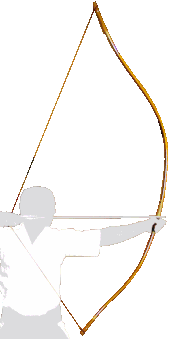
Yumi

| Yumi (弓) | |
|---|---|
Yumi from behind, profile | |
| Type | Asymmetrical bow |
| Place of origin | Japan |
| Service history | |
| Used by | Samurai, Onna-musha, Kyudo practitioners |
| Production history | |
| Produced | Since 3rd century (the asymmetrical yumi)[1] |
| Variants | Hankyū |
| Specifications | |
| Length | 212–245 cm (83–96 in) |
| Cartridge | Arrow length: 85–110 cm (33–43 in) |


Yumi (弓) is the Japanese term for a bow. As used in English, yumi refers more specifically to traditional Japanese asymmetrical bows, and includes the longer daikyū (大弓) and the shorter hankyū (半弓) used in the practice of kyūdō and kyūjutsu, or Japanese archery.

The yumi was an important weapon of the samurai warrior during the feudal period of Japan. It is typically shot with Japanese arrows known as ya.

The most famous style of yumi is an asymmetrically shaped long bow with a length of more than 2 m (6 ft 7 in), characterized by the archer holding the part of the bow below the center to shoot the arrow.[2][3]

History
Most of the excavated Jōmon period (c. 14,000–300 BCE) bows are 1.2 to 1.6 metres (3 ft 11 in to 5 ft 3 in) in length, while most of the Yayoi period (c. 3rd century BCE–2nd/3rd century CE) bows are 2 to 2.3 metres (6 ft 7 in to 7 ft 7 in) in length. The bows in these periods were made from a single processed wood, and the bows with this structure were called maruki yumi (丸木弓) and were used until the Nara period (710–794 CE).[4] It is unknown when the asymmetrical yumi came into use, but the first written record is found in the Book of Wei, a Chinese historical manuscript dating to the 3rd century CE, which describes the people of the Japanese islands using "spears, shields, and wooden bows for arms; the wooden bows are made with the lower limbs short and the upper limbs long; and bamboo arrows with points of either iron or bone."[1] The oldest asymmetrical yumi found to date was discovered in Nara Prefecture, and is estimated to be from the 5th century.

Some of the bows found as burial goods in kofun (ancient tombs) during the Kofun period (300–538 CE) were decorated with gold or silver, and it is believed that they were also used in ceremonies. The length of most bows in this period ranged from 70 to 150 cm (28 to 59 in), and it is thought that they were powerful enough to shoot enemies and animals at close range.[3]

In the Nara period, lacquered bows with more weather resistance and decorative features appeared. Euonymus hamiltonianus, Zelkova serrata, and Toxicodendron succedaneum, which are highly elastic wood, came to be used for making yumi, and many yumi became as long as roughly 7 shaku 3 sun (2.21 m (7 ft 3 in)), increasing their power and range. Since then, the structure of the bow has gradually evolved, but its length of roughly 7 shaku 3 sun has been passed down to the present day.[3][5]

From the mid to late Heian period (794–1185), the Japanese developed the fusedake no yumi (伏竹弓) style of yumi, the first yumi in Japan with a laminated structure. This style of yumi was made by attaching bamboo to a wooden yumi with a flat front side using glue made from a fish float, and the elasticity of the bamboo improved the bow's range, power and durability.[5][3] Nasu no Yoichi was famous as a master of archery in the late Heian period; his fame was depicted in The Tale of the Heike and Genpei Seisuiki, and he was the subject of various Japanese traditional performing arts and fine arts such as Noh, kyogen, kodan, kabuki, and ukiyo-e of later generations.[2]

From the end of the Heian period to the beginning of the Kamakura period (1185–1333), the sanmaiuchi no yumi (三枚打弓) was developed, and bamboo was glued not only on the front side but also on the reverse side of the yumi. In the late Kamakura period, the shape of the bow became more asymmetrical, with the upper part bent from the lower part, so that it resembled a modern bow, further increasing the range and power of the yumi.[3][5]

From the middle of the Heian period, the tōyumi (籐弓) style of yumi, in which rattan was wrapped around a laminated-structure yumi to improve its elasticity and sturdiness, became popular. The shigetō yumi (重籐) style yumi in particular was the strongest weapon of the Kamakura period, with a maximum range of 400 metres (1,300 ft) and an effective range of 80 metres (260 ft) that could inflict fatal wounds on targets. There are more than 20 varieties of shigetō yumi, depending on how and where on the bow the rattan is wound. In the Muromachi period (1336–1573), the shigetō yumi went from its luxurious exterior to a piece of equipment that symbolized the rank of commander.[4][6]

During the Kamakura period, when the samurai class came to power, kyūjutsu (archery) became more and more popular, especially the three types of mounted archery: yabusame, inuoumono, and kasagake.[7]

The shihodake no yumi (四方竹弓) was developed during the Muromachi period, and bamboo was used on the side of the bow to increase its range and power.[3]

During the Sengoku period (1467–1615), the higoyumi (弓胎弓) used in modern kyūdō was developed, completing the original form of the Japanese bow now known around the world. The characteristic of the bow is that it has a greatly changed laminated structure from the conventional bow. The core of the structure is about four pieces of bonded bamboo, with bamboo glued to the front side and the other side and wood glued to the sides. This improved the range and power of the bow and enabled it to shoot through targets 132 metres (433 ft) away in the Sanjusangen-do archery contest, Tōshiya, a famous event still held today. Research on yajiri (arrowheads) was actively conducted to enhance their killing ability, and yajiri of various shapes were developed. During this period, the tanegashima was mass-produced by Japanese swordsmiths, and mobilized ashigaru (foot soldiers) used them to exert tremendous power on the battlefield. However, because tanegashima took a long time to load, were inconvenient in rainy weather when damp gunpowder would not fire, and were not exactly subtle in terms of noise, the yumi did not go out of fashion and continued to be used as an important military force on the battlefield.[2][3]

When Japanese society became more peaceful in the Edo period (1603–1867), the spirituality and decorativeness of the yumi became important, and kyūjutsu developed as a samurai's way of doing things.[3]

Even today, the yumi is used in kyūdō and ceremonies, and in Grand sumo tournaments, a ceremony called the yumitori shiki (弓取り式), which is dedicated to Shinto kami, is held.[2]

| Time period | Type of bow | Bow formation |
|---|---|---|
| Prehistoric | Maruki | Single piece of wood |
| c. 800–900 | Fusetake or Fusedake | Wood with bamboo front |
| c. 1100 | Sanmaiuchi | Wood with bamboo front and back |
| c. 1300–1400 | Shihochiku or Shihodake | Wood surrounded with bamboo |
| c. 1550 | Sanbonhigo (Higoyumi) | Three-piece bamboo laminate core, wooden sides, bamboo front and back |
| c. 1600 | Yohonhigo (Higoyumi) | Four-piece bamboo laminate core, wooden sides, bamboo front and back |
| c. 1650 | Gohonhigo (Higoyumi) | Five-piece bamboo (or bamboo and wood) laminate core, wooden sides, bamboo front and back |
| c. 1971–Modern times | Glass fiber | Wooden laminate core, FRP front and back |
Shape
The yumi is exceptionally tall, standing over 2 m (6 ft 7 in) in height, and typically surpasses the height of the archer (射手, ite).[8] They are traditionally made by laminating bamboo, wood and leather, using techniques which have not changed for centuries, although some archers (particularly beginners) may use a synthetic yumi.

The yumi is asymmetrical; according to the All Nippon Kyudo Federation, the grip (nigiri (握り, lit. 'grip; handle; handful')) has to be positioned at about two thirds of the distance from the upper tip.


The upper and lower curves also differ. Several hypotheses have been offered for this asymmetric shape. Some believe it was designed for use on a horse, where the yumi could be moved from one side of the horse to the other with ease; however, there is evidence that the asymmetrical shape predates its use on horseback.[9]

Others claim that asymmetry was needed to enable shooting from a kneeling position.[citation needed] Yet another explanation is the characteristics of the wood from a time before laminating techniques.[citation needed] In case the bow is made from a single piece of wood, its modulus of elasticity is different between the part taken from the treetop side and the other side. A lower grip balances it.

The hand holding the yumi may also experience less vibration due to the grip being on a vibration node of the bow. A perfectly uniform pole has nodes at 1/4 and 3/4 of the way from the ends, or 1/2 if held taut at the ends – these positions will change significantly with shape and consistency of the bow material.[citation needed]

String
The string of a yumi, a tsuru (弦, lit. 'yumi bowstring'), is traditionally made of hemp, although most modern archers will use strings made of synthetic materials such as Kevlar, which will last longer.

Strings are usually not replaced until they break; this results in the yumi flexing in the direction opposite to the way it is drawn, and is considered beneficial to the health of the yumi.

The nocking-point on the string is built up through the application of hemp and glue to protect the string and to provide a thickness which helps hold the nock (hazu (筈/弭, lit. '[Japanese arrow] nock/notch') of the arrow, a ya (矢, lit. '[Japanese] arrow'), in place while drawing the yumi. However, it can also be made of strands of waxed bamboo.

Care and maintenance
A bamboo yumi requires careful attention. Left unattended, the yumi can warp out of shape and may eventually become unusable. The shape of a yumi will change through normal use and can be re-formed when needed through manual application of pressure, through shaping blocks, or by leaving it strung or unstrung when not in use.

The shape of the curves of a yumi is greatly affected by whether it is left strung or unstrung when not in use. The decision to leave a yumi strung or unstrung depends upon the current shape of the yumi. A yumi that is relatively flat when unstrung will usually be left unstrung when not in use (a yumi in this state is sometimes referred to as being 'tired'). A yumi that has excessive curvature when unstrung is typically left strung for a period of time to 'tame' the yumi.

A well cared-for yumi can last many generations, while the usable life of a mistreated yumi can be very short.

Bow lengths
| Height of archer | Arrow length | Suggested bow length |
|---|---|---|
| <150 cm (59 in) | <85 cm (33 in) | Sansun-zume (212 cm (83 in)) |
| 150–165 cm (59–65 in) | 85–90 cm (33–35 in) | Namisun (221 cm (87 in)) |
| 165–180 cm (65–71 in) | 90–100 cm (35–39 in) | Nisun-nobi (227 cm (89 in)) |
| 180–195 cm (71–77 in) | 100–105 cm (39–41 in) | Yonsun-nobi (233 cm (92 in)) |
| 195–205 cm (77–81 in) | 105–110 cm (41–43 in) | Rokusun-nobi (239 cm (94 in)) |
| >205 cm (81 in) | >110 cm (43 in) | Hassun-nobi (245 cm (96 in)) |
Gallery
-
Moto hazu (bottom nock)
-
Nigiri (grip)
-
Ura hazu (top nock)
-
Tsurumaki (string holder) and tsuru (string)
-
Antique hankyū (shortbow)
-
Antique daikyū (longbow) and hankyū (shortbow)
-
Yumi bukuro (cloth cover)
Popular culture
- Yumi are featured in the Teenage Mutant Ninja Turtles franchise, used by Splinter in Teenage Mutant Ninja Turtles II: The Secret of the Ooze and the 2003 episode "Exodus, Part 1". The Foot Clan includes Foot Archers who use yumi. Leonardo, Donatello, Raphael, and Michaelangelo occasionally used yumi in the 2012 version, and yumi were also used by Karai, as shown on the flashbacks of the 2003 episode "City At War, part 3". A yumi bow was used by Murakami Gennosuke, a rhino bounty hunter in the 2003 episode "The Real World, Part 1".
- Power Rangers Samurai features the Blue Ranger Kevin Douglas using the Hydro Bow, which is based on a yumi bow.
- Yumi bows were used by samurai in Deadliest Warrior and The Last Samurai.
- The character Hanzo Shimada from Overwatch uses a futuristic yumi as his weapon of choice due to him abandoning the way of the sword after nearly killing his brother Genji.
- Kikyo uses the Yumi bow as her preferred weapon of choice while her younger sister, Kaede did the same thing in her own right before and after her death and resurrection in Inuyasha both the anime and manga series
See also
- Kyūdō (弓道, "way [of the] bow")
- Kyūjutsu (弓術, "bow technique")
- Daikyū (大弓, a "great bow", a long bow)
- Chōkyū (長弓, a "long bow", also a long bow)
- Hankyū (半弓, a "half bow", a short bow)
- Azusa yumi (梓弓, a sacred bow used in certain Shinto rituals)
- Hama yumi (破魔弓, an "evil-destroying bow")
- Saigū yumi (祭宮弓, a "ceremonial bow")
- Ya (矢, an arrow)
- Yabusame
- Kasagake
- Shihan Mato
- Inuoumono
- Tōshiya
References
- ^ a b Records of the Three Kingdoms, Book of Wei: 兵用矛楯木弓木弓短下長上竹箭或鐵鏃或骨鏃
- ^ a b c d 弓・弓矢の基本知識 (in Japanese). Nagoya Japanese Sword Museum Nagoya Touken World. Archived from the original on 4 December 2022. Retrieved 4 December 2022.
- ^ a b c d e f g h 弓矢を学ぶ(弓編) (in Japanese). Nagoya Japanese Sword Museum Nagoya Touken World. Archived from the original on 4 December 2022. Retrieved 4 December 2022.
- ^ a b 弓 (Yumi) (in Japanese). Kotobank/Digitalio, Inc/Asahi Shimbun. Archived from the original on 4 December 2022. Retrieved 4 December 2022.
- ^ a b c 伏竹弓 (in Japanese). Kotobank/Digitalio, Inc/Asahi Shimbun. Archived from the original on 4 December 2022. Retrieved 4 December 2022.
- ^ 弓矢の歴史 (in Japanese). Nagoya Japanese Sword Museum Nagoya Touken World. Archived from the original on 4 December 2022. Retrieved 4 December 2022.
- ^ 弓術とは (in Japanese). Nagoya Japanese Sword Museum Nagoya Touken World. Archived from the original on 7 April 2022. Retrieved 14 December 2022.
- ^ Onuma, Hideharu (1993). Kyudo: The Essence and Practice of Japanese Archery (1 ed.). Tokyo: Kodansha International Ltd. p. 43. ISBN 978-4-7700-1734-5.
- ^ Friday, Karl (2004). Samurai, Warfare and the State in Early Medieval Japan. New York NY: Routledge. p. 69. ISBN 978-0-415-32962-0.
Further reading
- Herrigel, Eugen (1999). Zen in the Art of Archery. Vintage. ISBN 978-0-375-70509-0.
- Michael, Henry N. (1958). "The Neolithic Age in Eastern Siberia". Transactions of the American Philosophical Society. New Series. 49 (2). Philadelphia: The American Philosophical Society (published April 1958): 1–108. doi:10.2307/1005699. hdl:2027/mdp.39015018658560. JSTOR 1005699. S2CID 36624391.
External links
See what we do next...
OR
By submitting your email or phone number, you're giving mschf permission to send you email and/or recurring marketing texts. Data rates may apply. Text stop to cancel, help for help.
Success: You're subscribed now !



